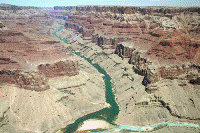United States Geological Survey

Geochemistry of Sulfate Minerals: A Tribute to Robert O. Rye
Date of this Version
2005
Abstract
Typical porphyry-type Cu–Mo mineralization occupies two connected domal centers, the eastern Pittsmont and western Anaconda domes, that predate and largely underlie the well-known, throughgoing, Main Stage polymetallic veins of Butte. Among the sulfur-bearing minerals recovered from deep drill core of this early pre-Main Stage hydrothermal assemblage are anhydrite, chalcopyrite, pyrite, and molybdenite in veinlets bordered by K-silicate alteration, and pyrite from slightly younger quartz–pyrite veinlets with dgray-sericiticT alteration selvages. The ranges of δ34S values for minerals of the K-silicate assemblage are 9.8–18.2%◦ for anhydrite (n=23 samples), 3.0%◦ to 4.7%◦ for molybdenite (n=6), 0.4%◦ to 3.4%◦ for pyrite (n=19), and ‒0.1%◦ to 3.0%◦ for chalcopyrite (n=13). Sulfate–sulfide mineral fractionation is consistent with an approach to isotopic equilibrium, and calculated temperatures for mostly coexisting anhydrite–sulfide pairs (anhydrite–molybdenite, n=6, 545 to 630 °C; anhydrite–pyrite, n=13, 360 to 640 °C; and anhydrite–chalcopyrite, n=8, 480 to 575 °C) are broadly consistent with petrological, alteration, and fluid-inclusion temperature estimates. The δ34S values for pyrite (n=25) in veinlets of the dgray-sericiticT assemblage range from 1.7%◦ to 4.3%◦. The δ34S values for sulfides of the pre-Main Stage K-silicate and 'gray-sericitic" assemblages are similar to those of most Main Stage sulfides, for which 281 analyses by other investigators range from ‒3.7%◦ to 4.8%◦. Sulfide–sulfide mineral pairs provide variable (‒175 to 950 °C) and less reliable temperature estimates that hint of isotopic disequilibria. The sulfide data, alone, suggest a conventionally 'magmatic" value of about 1%◦ or 2%◦ for Butte sulfur. However, the high modal mineral ratios of sulfate/sulfide, and the isotopic systematics of the early K-silicate assemblage, suggest that pre-Main Stage fluids may have been sulfate-rich (XSO4 2‒≈0.75) and that total sulfur was isotopically heavy (δ34SΣS≈10%◦), which would have required an evaporitic crustal component to the relatively oxidized granitic parental magma that was the source of the hydrothermal fluids and sulfur. Modeling of brine–vapor unmixing of a 10%◦ fluid, reduction of sulfate, and vapor loss suggest that these processes may have formed the isotopically heavier (14%◦ to 18%◦) anhydrite of the western and shallower Anaconda Dome, contrasting with the lighter and more numerous values (9.8%◦ to 12.9%◦) for anhydrite of the eastern and


Comments
Published in Chemical Geology 215 (2005)